Written by Michael Auliso and republished here with his permission.
Missing some random photographs on page 1 and all photographs on page 2
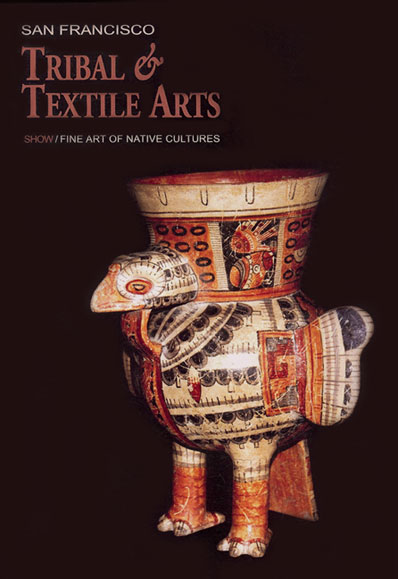
“The European Exodus”
Reviewing the recent San Francisco Tribal art gathering has taken longer than usual to write as I keep shifting through not only my own assessment, but those of other participants, dealers, and collectors. As usual, the show was beautifully appointed and well-executed by the Caskey family and its very competent crew. The market appears to have improved slightly over last year. There was a perceivable up-tick in consumer confidence and spending by an estimated 10-15%. That is positive news but this market was so far down that it was poised for a bounce, however modest. The recovery will likely be slow going forward since consumers are still tapped out, unemployment remains high and commodity prices are up (inflation) across the board.
This year’s great success story belongs to German dealer Rudolph Smend, Rudolph is one of the world’s great experts and dealers in antique batik from Indonesia. His large exhibition in the foyer was noteworthy for its breadth of quality and beauty. It was also a financial success proving that when a corpus of good material is exhibited, when there is choice, and no confusion about quality or veracity, the public positively responds. This exhibit effectively raised the status of the Art of Batik which has typically sold for fairly modest prices in the past. He sold a number of them and one reportedly for $20,000+.
This year there was a HUGE donut hole in the participation of dealers, especially the Europeans! European collectors with few exceptions were absent too. The “bubble” for this show was in 2007 when there was a waiting list to get in and the top dealers on the planet wanted to exhibit. In four short years due to the economy, buyer apathy, and other factors, the demand among dealers to exhibit has cascaded. This is a seriously dangerous trend and its continuation could ultimately mean that the show fades away. I’m not fear mongering but the reality is that it happened to the New York Tribal Show held at the Armories. This show venue could be in SERIOUS trouble. I do hope I’m wrong. The demise of any show is not preordained but it is important people are aware of the attrition of dealers so it can be addressed.
Astonishingly this year there were several “empty” booths. Many of us were surprised. To fill the voids the show promoters either walled these booths off or dealers with extra material helped fill the vacancies. This was the case with the booth next to me. This is an unprecedented occurrence for this show! This is the last great show remaining in the States and if collectors wish to see it continue then please come out and support it, otherwise all that is left are the auctions, and a very few galleries.
To help understand the huge void of dealers that dropped out this year the list is as follows, American Dealers: Peter Boyd , Ramona Morris, Pace Primitive, Acquisitions Inc. and Primary Source. European dealers: Kevin Conru, John Giltsoff, Olivier Castellano, Galerie 1492, Riccardo Columbo, Yann Ferrandin, Alberto Levi, Edith Mbella, Joanquin Pecci, Serge Schoffel and Renaud Vanuxem. If that is not an exodus I don’t what is. Mind you, this is only the tribal dealers. If I was to include the textile and jewelry dealers the list would be even longer! As an aside, last year saw at least a dozen dealers who dropped out that were exhibiting in 2009. The trend is clear. When looking at these names, if you’re thinking the overall quality of the material “dropped” you’re right on.
Under current economic circumstances the absence of European dealers is largely understandable. It’s unfortunate they couldn’t have hung in there a bit longer since the market is just now beginning to recover. For an international exhibitor it costs between $11,000-$15,000 (Booth, lights, pedestal and showcase rental, shipping, hotel, airfare, etc…. Thus, sales of at least $20,000 are required to make the show even feasible. Last year a dealer was lucky to break even let along see a profit, so few probably see any point in returning. Soon after the deep recession set in, the promoters would have been wise to slash exhibition cost by at least 20% to help mitigate the damage to the show (hindsight is 20-20). This is speculation, but it could have allowed quality dealers to stay in the show and to coax others that already left to get back in? Unfortunately that didn’t happen and I predict more dealers will likely drop out next year especially if we see the weak dollar trend continue.
It was interesting to see which dealers the show promoters recruited to fill all of these empty slots. There were some new dealers trying to establish themselves, semi-retired dealers, dealers who sporadically exhibit and finally collectors who became dealers by default.
The atmosphere was notably less intense and serious this year. During the show I heard a number of dealers remark that they didn’t sell anything opening night and how attendance seemed low. Ahem….. with a $150 price per person what would you expect? That feels like too much. Most people stay around the catered food court area trying to eat and drink their money’s worth, most do a pretty good job I might add. At that ticket price looking at Tribal Art seems secondary!? Even active collectors tended to wait until Friday morning for the $10 general admission price before shopping.
A busy Saturday Afternoon
Miranda Crimp, Sausalito CA
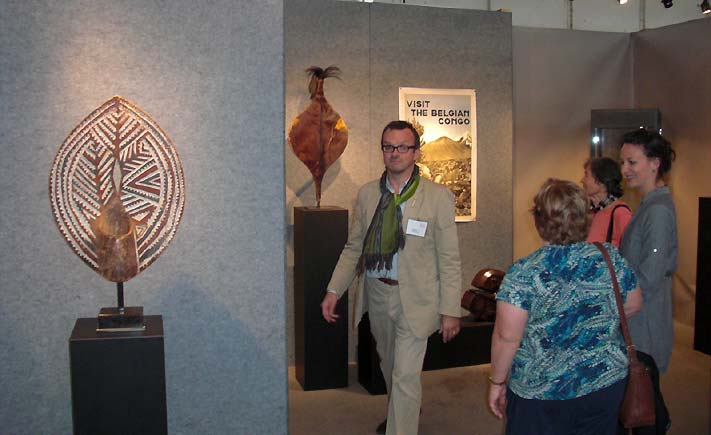
Patrick Mestdagh, Brussels with a fine Kikuyu Arm shield from Kenya
Mestdagh, (upper left) A hide and Monkey fur shield likely from the Kaseng of Southeast Laos. Note the fine Japanese Keyaki kettle hook hanger in the lower right
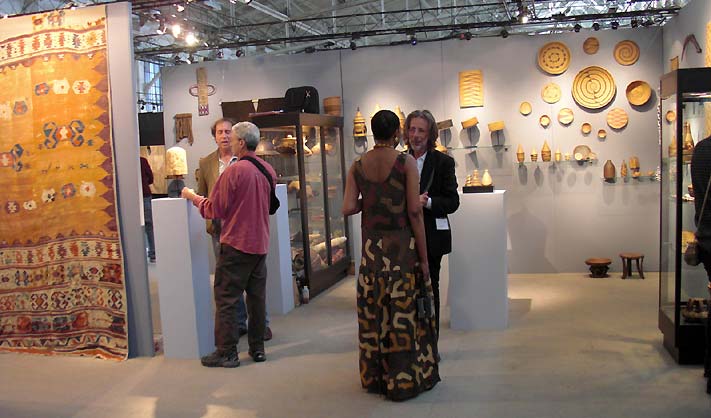
Marcuson & Hall whose booth is right off the food court specialize in the fiber art always has a fine selection of Tutsi baskets and textiles
Tribalmania with a theme exhibit of “Tribal Arms”. I had good intentions of taking more photos of the show but there always seemed to be a steady flow of people making for long conversations and little free time.
My friend Neil Becker “New World Antiquities” of West Harrison NY, brought a great selection of Eskimo and Northwest Coast Art. Note his Yupik Eskimo finger dance fan (Tarayamaarutet)
(Neil Becker) A great selection of ancient Eskimo Ivories
(Neil Becker) A classic Northwest coast Chilkat blanket
(Neil Becker) A Yupik Eskimo transformational mask
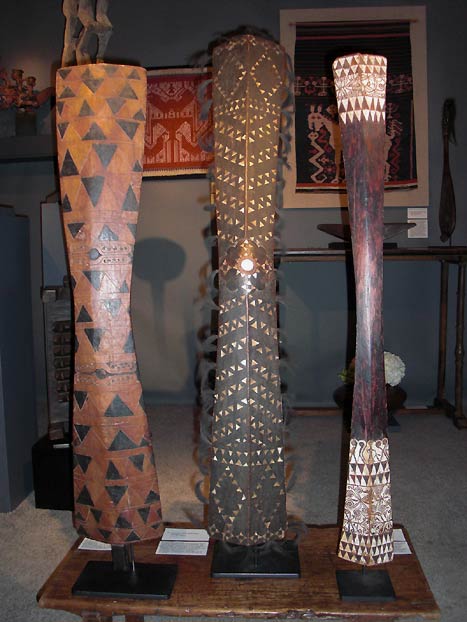
Vicki Shiba, Mill Valley CA with an amazing group of early parrying shields from the Moluccas Island, Indonesia
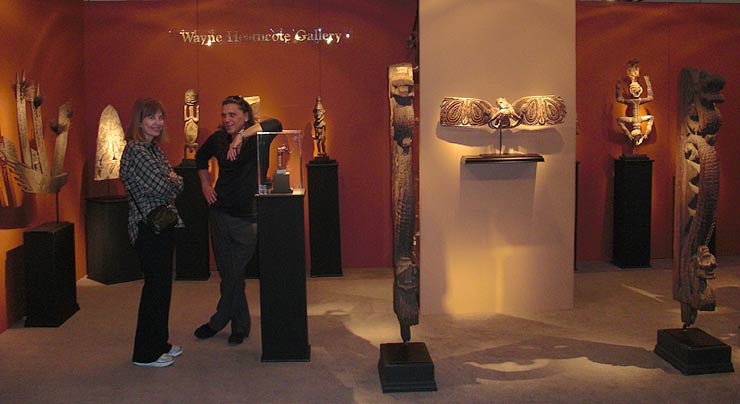
Booth of Wayne Healthcote and Jack Sadovnic (Sharon Singer chatting with Jack Sadovnic) Jack sold this rare and early pair of throne supports from Lampung, South Sumatra
Wayne Healthcote with a splendid Maori Treasure box (probably early 19th century)
Art Passages, Shawn Ghassemi San Francisco. Maori flax cloak, New Zeland
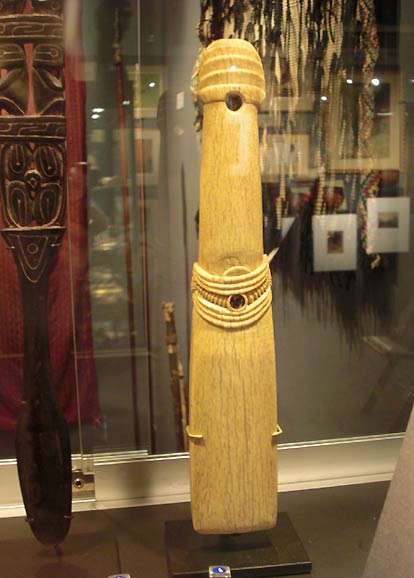
Art Passages, Maori whalebone hand club
This sizeable New Guinea Middle Sepik suspension hook was in the booth of Dave DeRoche. This year Jo De Buck from Brussels were back sharing their same large booth toward the entrance of the show.
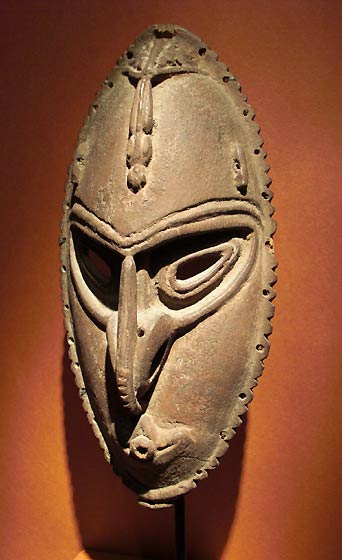
These lovely pieces were in the booth of Bruce Frank (left) a small masterful New Guinea Sepik maskette (right) a Songye Fetish (bottom) a New Guinea Iatmul flute stopper
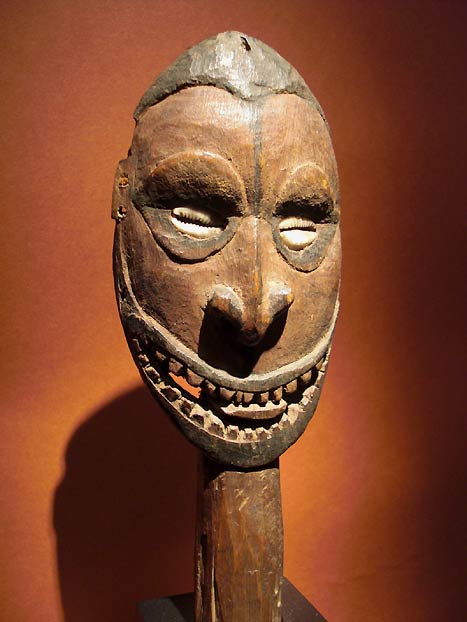
Brant Mackley, Hershey Pennsylvania with a rare Eskimo walrus effigy harpoon storage box circa 1900
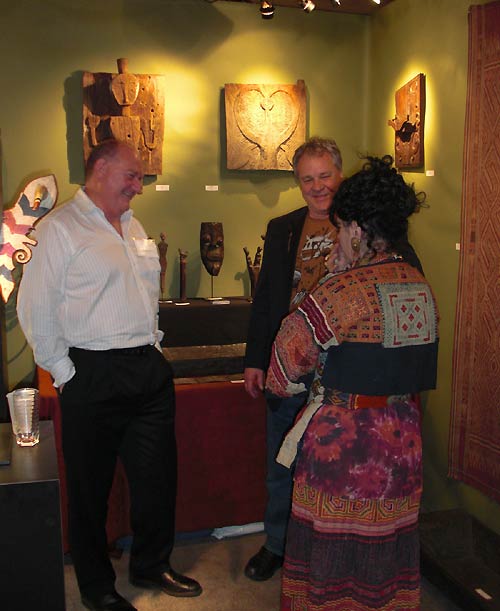
Mark Johnson’s Booth (center), Bill Sutterfield (left) and Linda Pastorino holding in a sneeze. On the back wall (upper left) is a Toraja shrine vault panel from Sulawesi
B.C. Denton, San Francisco, with an unusual Japanese mask
Kirby Lewis (Seattle), with a fantastic Aboriginal Coolamon dish and a 19th century New Caledonian figure (right)
James willis (San Francisco) with a large Dogon female figure from Mali
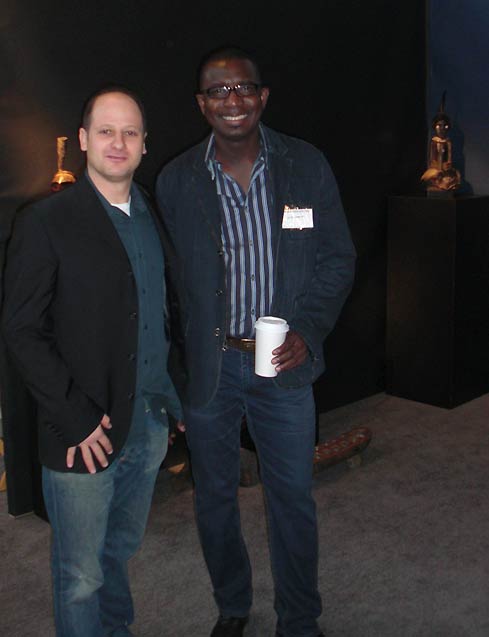
Seabastian Fernandez (New York) and Fily Keita (Los Angeles)
Michael Evans, Dijon France. Mike had a great display of 9 black and white photographs of Maori tattooed heads “mokomokai” by Horatio Robley. They are pictured in the catalog but they sold before I had a chance to shoot a photo.
(Michael Evans) Among many sales, Mike sold this New Britain nassa shell neck ornament
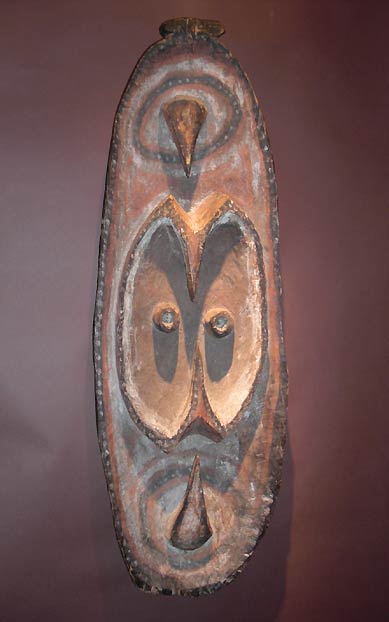
Joel Cooner (Dallas Tx) with an early New Guinea Hunstein garra hook mask, Bahinemo People
Joel Cooner with Jack Sadovnick. Joel, that 5th cappuccino looks like it is really working!
Cathy Cootner, Sonoma CA
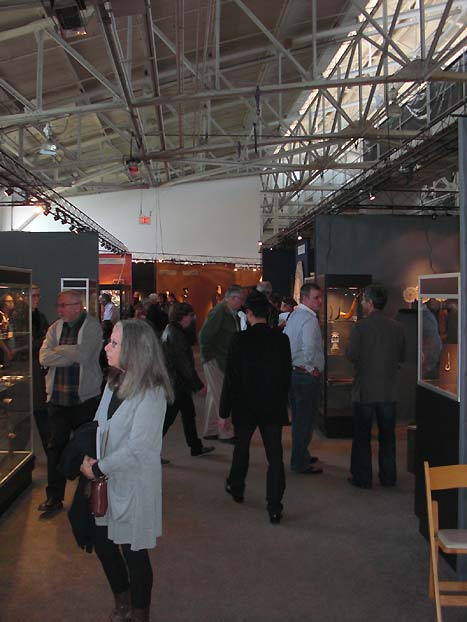
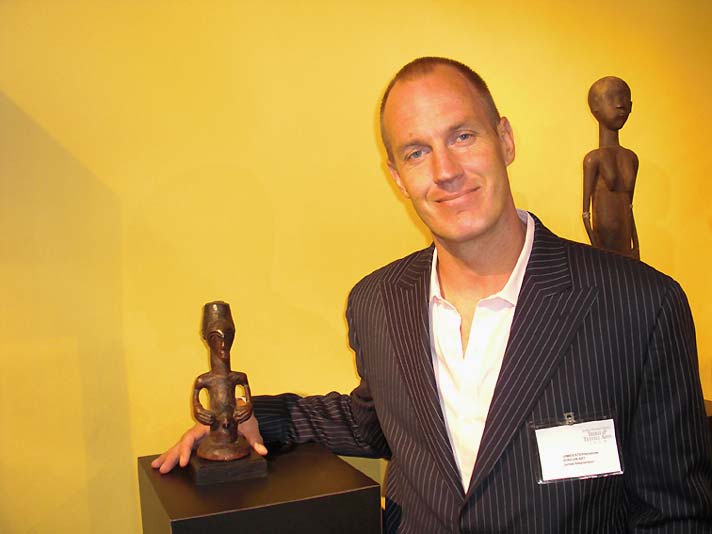
James Stephen (Brooklyn NY) next to a Luba Fetish. James as promised everyone that he won’t use that yellow wallpaper anymore.
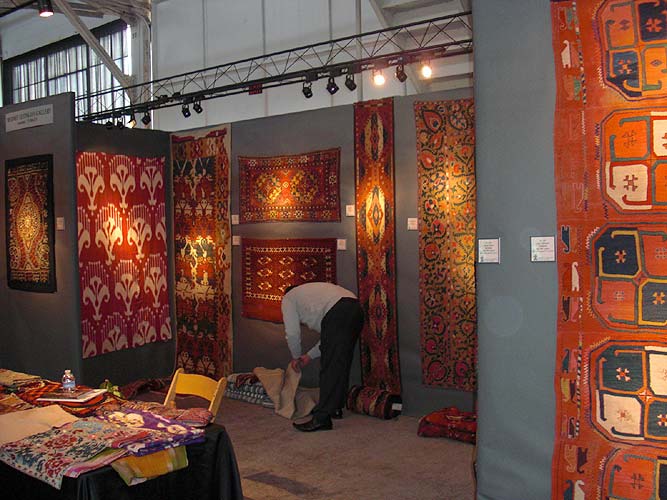
Mehmet Cetinkaya Gallery, Istanbul Turkey. I’m always envious of the textile dealers who I’ve seen break down their booth in just minutes and have everything packed up in one or two suitcases!
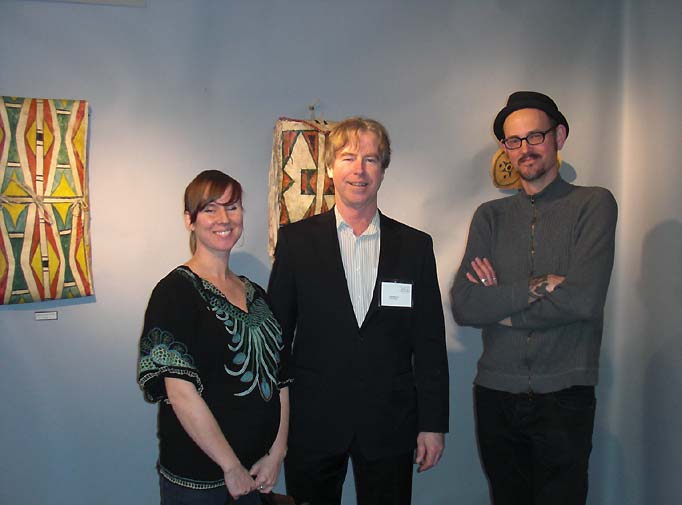
(Center) John Molloy- New York (right) Ingmars Lindbergs, Bonhams and Butterfield’s specialist
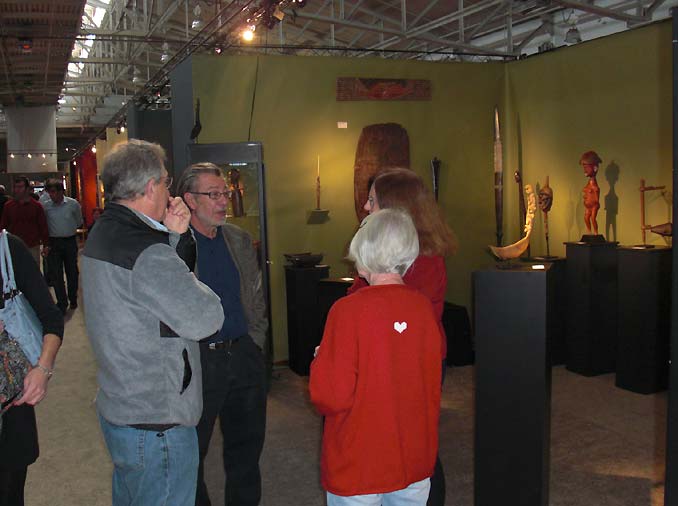
Tad and Sandy Dale, Santa Fe New Mexico talking to Clinton Nagy and his wife (foreground)
(Dale) with the oldest New Guinea Lumi Shield I’ve ever seen.
(Dale) with an impressive master-carved Songye Prestige Stool from the Frank Crowninshield collection New York (Ex. Sotheby’s NY 2002). This was my favorite piece in the show. Unfortunately it was not on display long. It sold immediately opening night with the buyer taking it home.
A shot showing part of the food court. Any booth surrounding this area is prime “real estate” and costs the dealers a premium
The show winding down, late one afternoon, or it could have been that hot Cajun jambalaya that sent people home 🙂
Joris Visser (Brussels), New Guinea Abelam painted bark panels, (right) New Guinea Highlands “Timbuwarra” figure
An under $5000 venue?
Comparing notes with other dealers reveals a clear trend. Most sales at the show were under $5000. That has been my experience too. Of course there were some 5 figure sales but likely no 6 figure sales. Dave DeRoche said he sold over 20 pieces but nothing priced over $4000. Sure there were some large sales but overall the average ticket price is modest. This is a conundrum for dealers with high exhibition costs like Europeans and East Coasters who rely on a high ticket sale to make the show worthwhile. Some dealers make the mistake of only bringing high-end pieces. Their booth may look great but they risk selling little or nothing. The necessary composition needs to be a blend of all price ranges it appears.
Fewer dealers spell Equilibrium? While the dynamics are complex with 100+ dealers, it was evident that fewer dealers (100 vs. 108 from last year) meant the market in San Francisco could more comfortably support a smaller pool of exhibitors. My guess is that given the current market, the optimum number of exhibitors is in the 90-95 range. Arguably the “Parcours des Mondes” in Paris grew so fast that it could shed some dealers as well to bring it more in harmony with the market demand during that week in September. As opposed to past years most dealers were at least able to make their expenses and some actually did quite well like Sebastian Fernandez and Howard Nowes for example.
Collectors have commented to me on the lack of major pieces this year and others. Collectors and dealers are at an impasse on this issue. While the collectors are reluctant to attend because of the lack of exciting pieces, the dealers are reluctant to have their best pieces exposed in San Francisco because of the likelihood they won’t sell and then be overly exposed. For this reason this show appears to be slowly morphing into a “decorative” design show with fewer serious pieces on display to draw enthusiasts.
I could write volumes on the topic of the VETTING and have in previous years. While the subject is particularly sensitive, it’s more of an issue than ever, if the show is to continue to live up to its billing and reputation. The Vetting procedure hasn’t changed and now there is an under current about the veracity of the show. Collectors, auction houses, old-timers, and persons of noted expertise watch what we all do in the public arena and on the internet. This is a topic that is discussed not only widely by the public, but quietly questioned by many participants in the show. Unfortunately, this year’s vetting was particularly political, subjective, and at times sloppy. It is still exclusively done by competing, in-house dealers to everyone’s detriment. Unfortunately, those with independent expertise that “should” be vetting the show, now refuse to do it, and with good cause. Requiring exhibiting dealers to vet the show is not only a huge burden on those dealers who are asked to do it, but represents in real or perceived terms potential conflicts of interest.
Frankly, many question why even have a vetted show when they’ve seen good pieces tossed out and bad ones remain? The standard for the vetting has been “pre-1940” for the last 25 years, perhaps this should be updated as a criteria, and replaced by allowing later pieces still made for use by “living cultures” into the show. In the past, dealers have been known to stretch the age of a piece on a label to say it is older than it is to clear that hurdle.
This is a tough topic to address but to insure permanence and maintain the status of the show a new approach seems necessary. I care about this show and to retain its luster some innovative changes must happen.
1) Its time for the show to be “professionally vetted” by non-dealers. The show costs the exhibitors plenty, so the promoters need to be cooperative and recruit independent, knowledgeable, curators, collectors etc. do to the vetting now and forever. With the average booth costing $4000, and there being at least 100 dealers, the promoters spending $20 to $50 per booth fee to get in some local experts doesn’t seem that impossible or that much of a hardship. Maybe one or two fewer plates of chocolate covered strawberries, would cover the cost? I know that bringing in unbiased vetters would go a long way with the dealers and affirm a commitment to fairness and excellence on the side of the promoters. If paying a portion of the booth fee is required to get that necessary talent, then lets all get behind that and making it happen.
2) Another problem as I see it is that to fill space, the promoters have allowed “grey area” sellers into the show with questionable items regarding age and quality. Not specifically tribal pieces, but more often other categories. Whereas the tribal dealers are held to a stricter code of age and quality, these others have almost no quality control it appears, as I saw pieces being displayed with “new” on their tags! If the Tribal Dealers are held to a higher standard how can these “other” sellers be allowed to be in the show, just so spaces will be filled. A smaller, better show would be best for all. Seems like a double standard to me.
3) The Tribal dealers must make a greater effort to correctly label pieces with dates, provenance, collection history etc. to insure the confidence of buyers. Dealers known by many to be operating in “gray areas” should take notice that the tribal art community is aware and watching — Let’s all work towards having this venue continue as it has in years past– America’s Best Tribal Art Show. Discussing the vetting topic honestly and often, then implementing changes is required to make the show better for everyone and preserve its longevity. The old methodology is not only antiquated but is slowly damaging the show.
Clive Loveless (London) next to a New Guinea Green River Shield
Loveless (above left) A rare internal window shutter from urban Moroccan (Rabat or Meknes), 43 ins, circa 1800
(detail) window shutter with eye-dazzling pattern
H. Kellim Brown (Brussels)
Insite Antiques and Design- San Francisco (Left) Aboriginal bark painting
Alan Naoum (Brussels) Songye figure
Julian Falk- Paris, caught by surprise
(Galerie Falk) an early New Guinea Sepik Mask. This year Julian did the show by himself giving his parents a break
Thomas Murray- Mill Valley (Right) A very fine Mexican Saltillo Serape
(Murray)
Tom sold this entire group of beautiful celts from various cultures
(Murray)
Ted Danson (look-a-like) examining a Nias ancestor figure
Insulinde Indonesian Arts- Forest Knolls CA. Frank Wiggers back exhibiting again at this show again after a long hiatus
John Ruddy (Santa Fe, NM)
Stendahl Galleries Fine Pre-Columbian Art (Los Angeles) Ronald Dammann talking with collector Joel Greene (Right)
Cocoon- Istanbul with a fine Suzani (Right)
David Cassera (New York) next to a published Kono mask from Mali
James Barker (Santa Fe NM) Exhibiting for the first time in San Francisco
Bill Sutterfield (Alamedia CA) exhibiting for the first time in San Francisco
Singkiang (Chester NJ) Linda’s booth is always jammed with women admiring her jewelry, garments and more
Bryan Reeves (Tribal Gatherings- London) Brian just opened a new gallery, we wish him success!
Craig DeLora (Lyndhurst NJ) sold this Igbo Ikenga Shirne figure
My partner Carol Katt with a Mexican Fiesta Grande’ dance dress (Chiapa de Corzo)
Russo, from Mexico City (collector and tattoo artist)
Exhibiting for the first time at the show “One World Tribal Art” Sheridan and Callie Oakes (San Francisco)
Oceanic dealer Chris Boylan Sydney
Josh Dimondstein with a Nigerian Ibo mask framed by a pair of Oliphant ivory trumpets
Andrew Berz Sujaro Gallery San Francisco
Louis Nierijnck- Maastricht. Louis is one of a handful of dealers that sells well at any show he does. Continued success to you Louis!
An impromptu visit to my booth from Bill Jamieson’s camera crew
They were filming an episode of Bill’s new show “Chasing History” (working title) to air in the fall, (right) Bill’s co-star and famous “fashionista” Jessica.
While the camera rolls, Bill and I haggle over the price of an 18th century Fijian Ula throwing club with inset human teeth. He drives a hard bargain but we did the deal!
“Conversations”
with 21 exhibitors and show personnel
THE END
